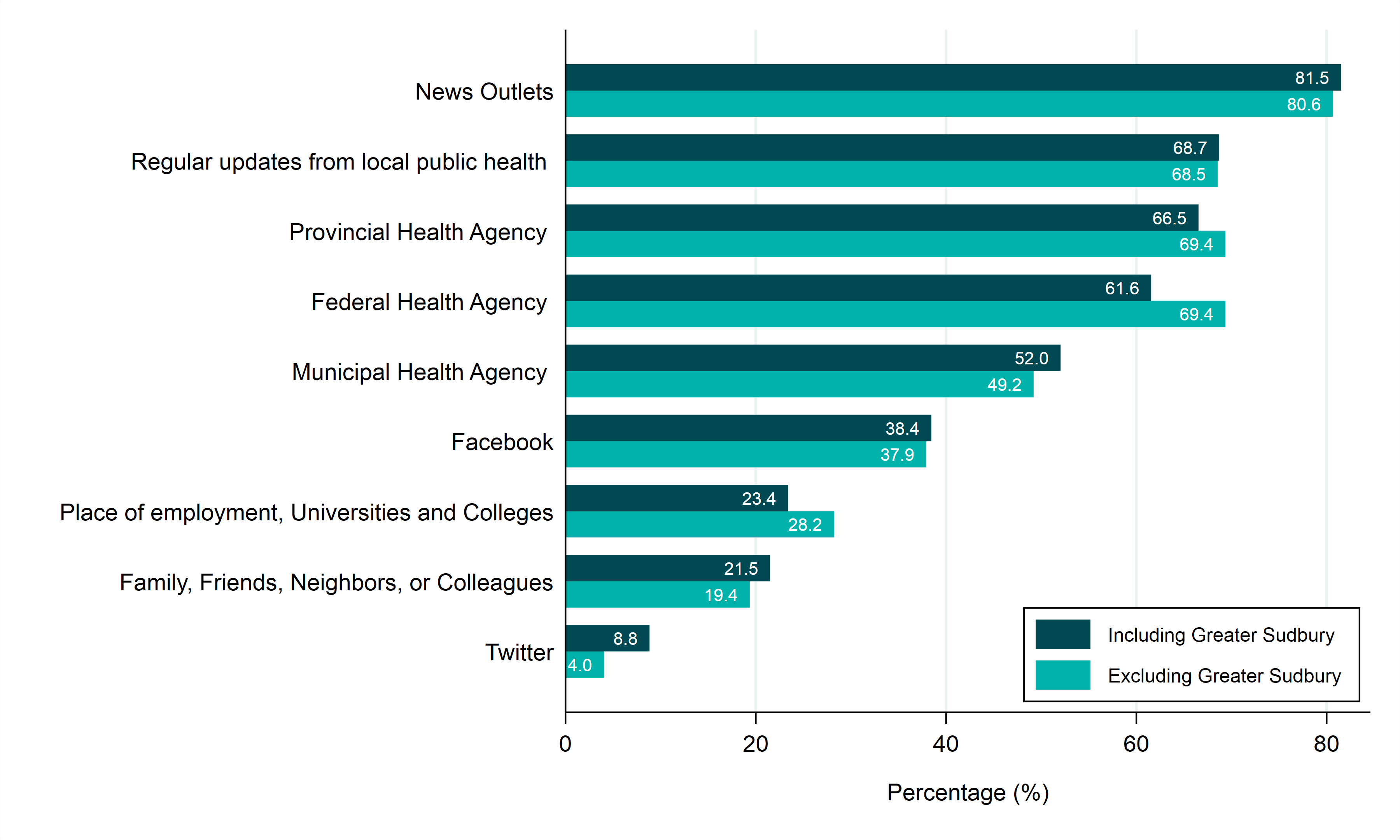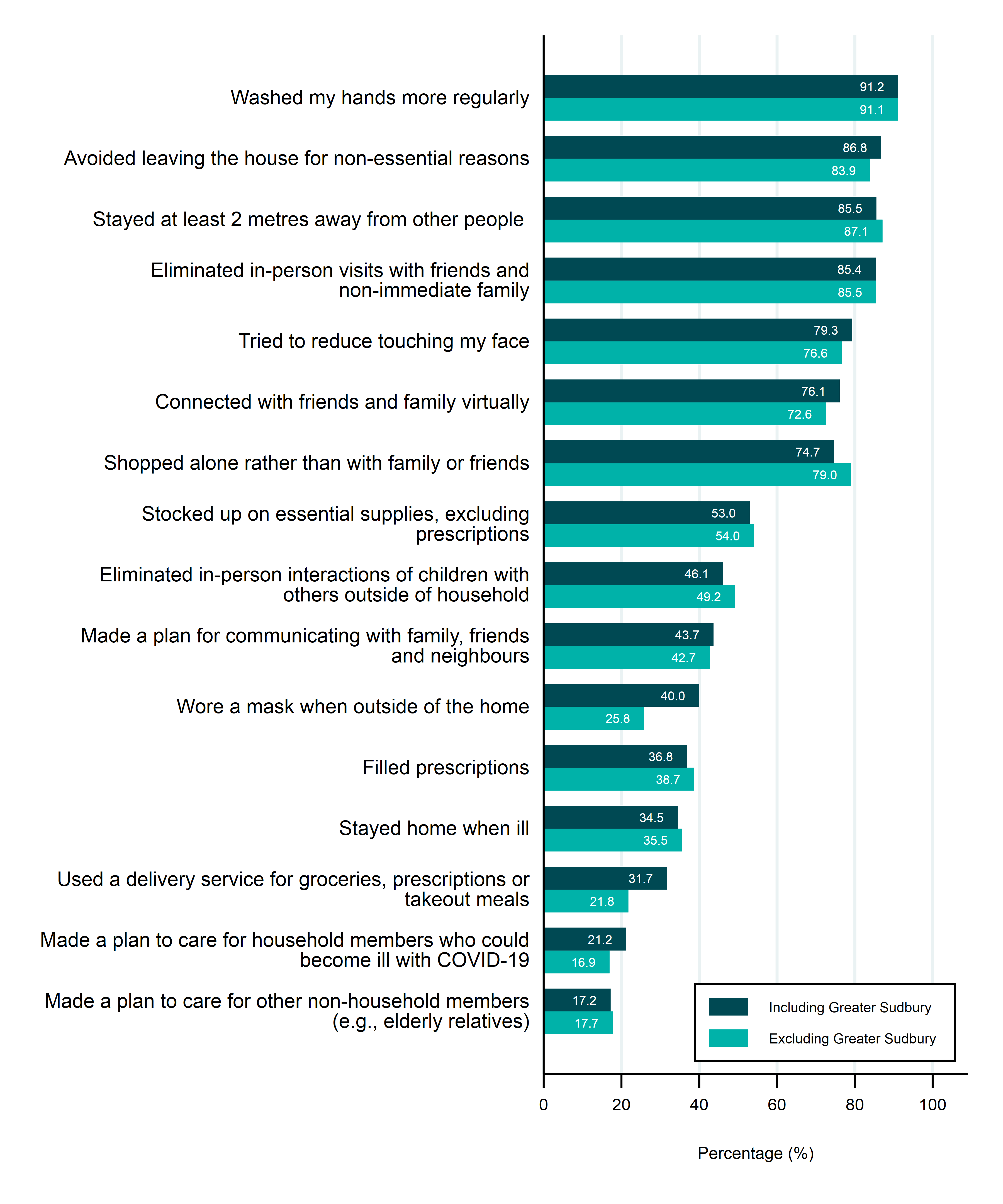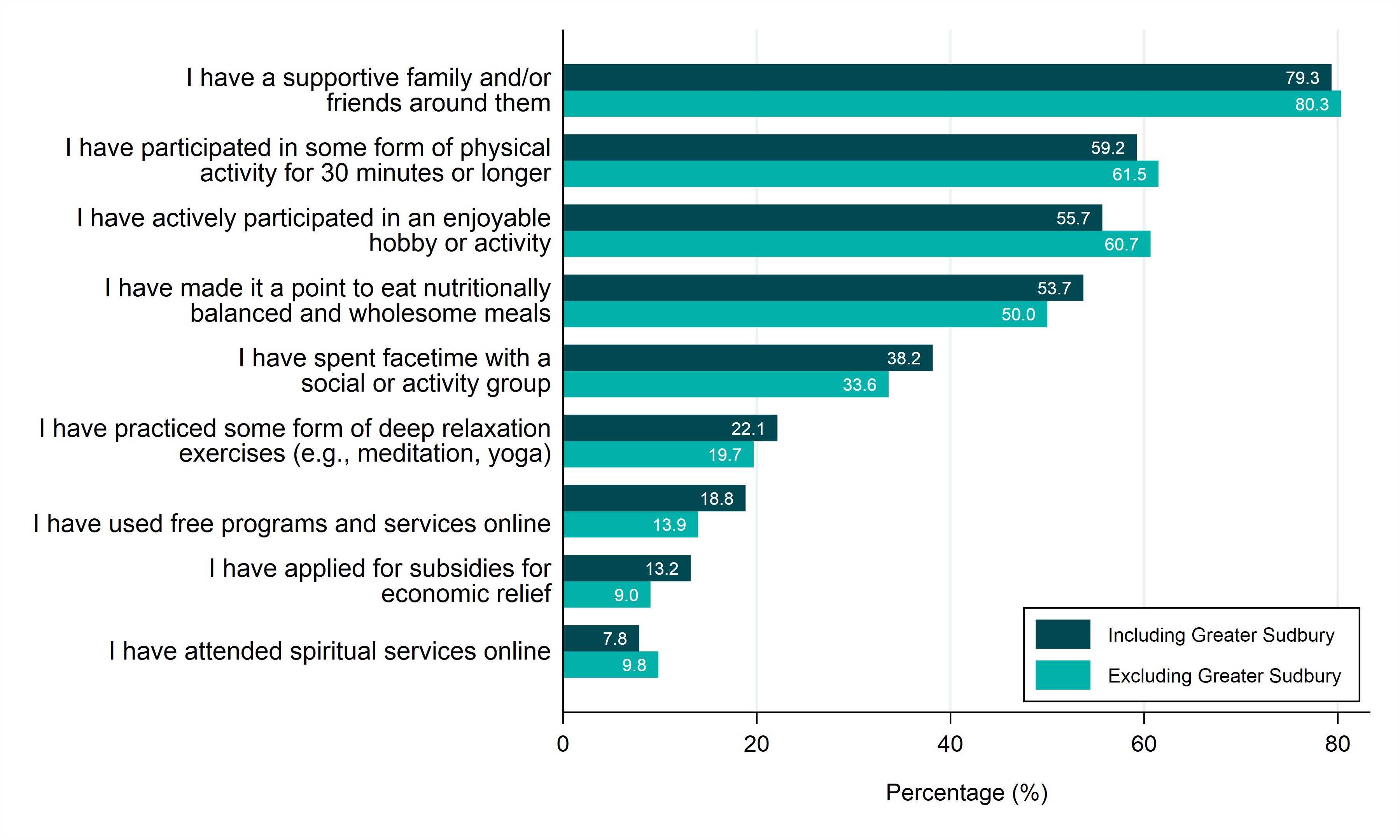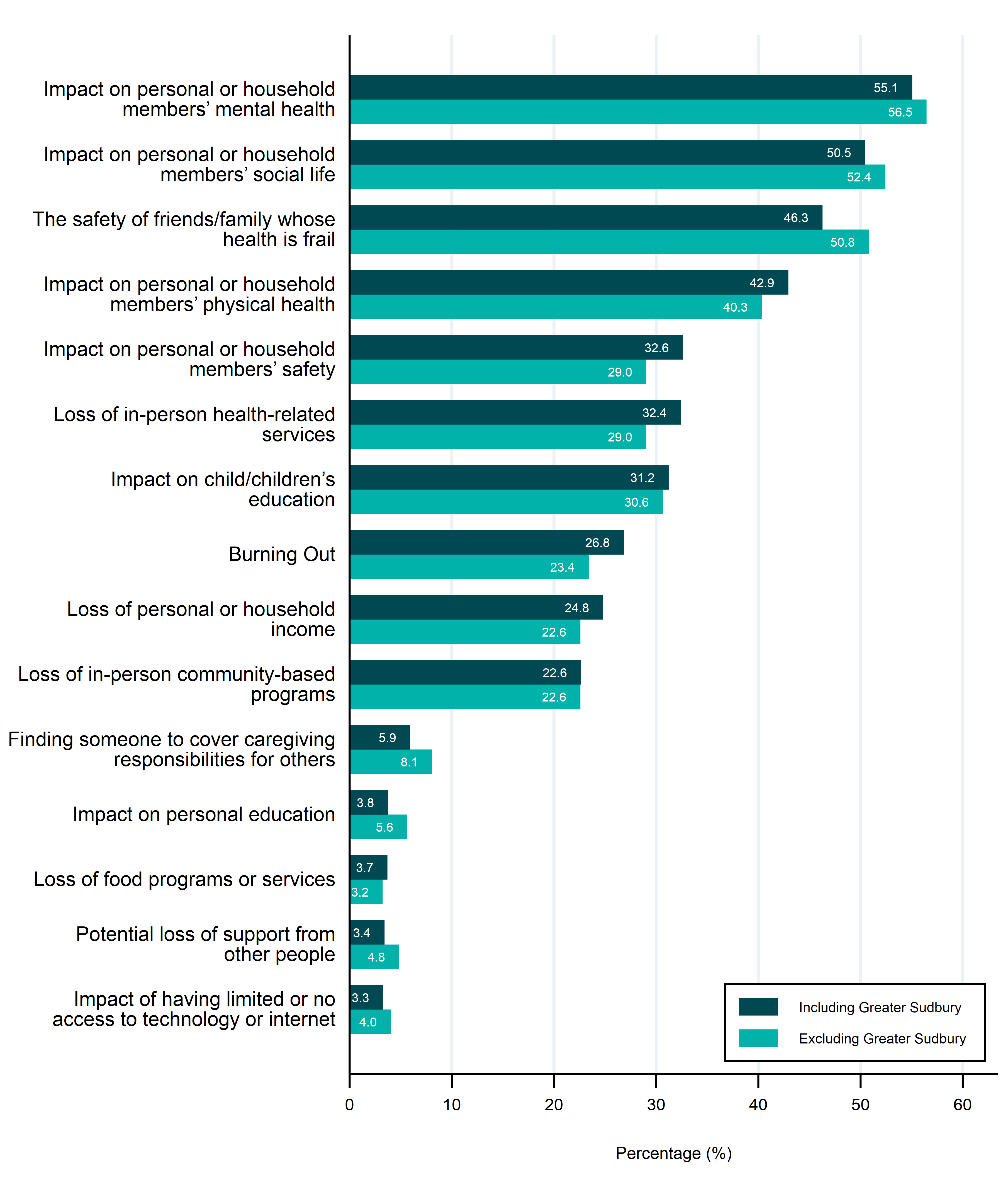Experiences and impacts of COVID-19 in Sudbury and districts
PDF Version (PDF, 342 KB)
Public Health Sudbury & Districts conducted an online bilingual community survey to understand how COVID-19 is affecting and impacting residents in Sudbury and districts. The survey was open and advertised on social media over twelve days from April 29, 2020 to May 10, 2020. These results are used to inform public health planning and service coordination.
Sample
- 1,436 surveys were completed
- 91% reported residency in Greater Sudbury
- 3% completed the online survey in French
- 74% of the sample identified as female
- 60% of respondents were between the ages of 25 and 54 years
- 4% reported living in poverty and/or experiencing food insecurity
- 17% reported having a chronic (long-term) illness (e.g. asthma, diabetes, cancer, arthritis)
- 4% reported living with a physical, developmental or sensory disability
- 17% reported living with a mental health disorder (e.g. anxiety, depression)
- 62% of working respondents (n=762) were working from home (n=473)
- 60% of respondents absent from work (n=230) were off because of a business closure or layoff related to COVID-19 (n=139)
Primary Sources of Information about COVID-19
Key findings:
- The primary sources of COVID-19 information used by all participants in Sudbury and districts included local, national and international news outlets (82%, n=1164), followed by regular updates from local public health (69%, n=981) and the provincial health agency (67%, n=950).
- News outlets was identified as the top source for each age category from 16 to 55+ years (72%-91%).
- District respondents were less likely to use Twitter as a source of information about COVID-19 than the total sample (4%, n=5).

| Sources of Information | Total | Districts |
| News outlets | 82% | 81% |
| Regular updates from local public health | 69% | 69% |
| Provincial Health Agency | 67% | 69% |
| Federal Health Agency | 62% | 69% |
| Municipal Health Agency | 52% | 49% |
| Facebook | 38% | 38% |
| Place of employment, Universities, Colleges | 23% | 28% |
| Family, Friends, Neighbours, Colleagues | 21% | 19% |
| Twitter | 9% | 4% |
Precautions Taken to Reduce Risk
Key findings:
- The primary precautions promoted by public health to reduce the risk of exposure to COVID-19 are being taken by survey participants.
- Regular hand washing was the most reported precaution taken by all age groups in Sudbury and districts (91%, n=1309).
- Persons with a chronic (long-term) illness (n=245) reported the same top five precautions as all survey respondents combined.
- District respondents were less likely to wear a mask outside of the home (26%, n=32) or use a delivery service for groceries, prescriptions or take-out meals (22%, n=27) than the total sample.

| Precautions | Total | Districts |
| Washed my hands more regularly | 91% | 91% |
| Avoided leaving the house for non-essential reasons | 87% | 84% |
| Stayed at least 2 meters away from other people | 86% | 87% |
| Eliminated in-person visits with friends and non-immediate family | 85% | 86% |
| Tried to reduce touching my face | 79% | 77% |
| Connected with friends and family virtually | 76% | 73% |
| Shopped alone rather than with family or friends | 75% | 79% |
| Stocked up on essential supplies, excluding prescriptions | 53% | 54% |
| Eliminated in-person interactions of children with others outside of household | 46% | 49% |
| Made a plan for communicating with family, friends and neighbours | 44% | 43% |
| Wore a mask when outside of home | 40% | 26% |
| Filled prescriptions | 37% | 39% |
| Stayed home when ill | 34% | 36% |
| Used a delivery service for groceries, prescriptions or takeout meals | 32% | 22% |
| Made a plan to care for household members who could become ill with COVID-19 | 21% | 17% |
| Made a plan to care for other non-household members (e.g., elderly relatives) | 17% | 18% |
Personal Situational Assessment
Key findings:
- The primary sentiment from participants in all age categories, 16 to 55+ years, in Sudbury and districts was the feeling of having a supportive family and/or friend (79%, n=1133).
- This primary finding was further expressed by persons living with a mental health disorder (n=240) and persons living in poverty or experiencing food insecurity (n=55).
- Fewer respondents from the districts applied for economic relief subsidies (9%, n=11).

| Statement | Total | Districts |
| I have a supportive family and/or friends around them | 79% | 80% |
| I have participated in some form of physical activity for 30 minutes or longer | 59% | 62% |
| I have actively participated in an enjoyable hobby or activity | 56% | 61% |
| I have made it a point to eat nutritionally balanced and wholesome meals | 54% | 50% |
| I have spent facetime with a social or activity group | 38% | 34% |
| I have practiced some form of deep relaxation exercises (e.g., meditation, yoga) | 22% | 20% |
| I have used free programs and services online | 19% | 14% |
| I have applied for subsidies for economic relief | 13% | 9% |
| I have attended spiritual services online | 8% | 10% |
Impact of COVID-19
Key findings:
- Overall, the primary concern identified by the survey sample in Sudbury and districts was the impact of mental health on self or others in the same household (55%, n=790).
- Persons with a chronic (long-term) illness (n=245) reported the loss of in-person health related services for themselves or others in their household as one of their top five concerns.
- Additionally, persons living in poverty or experiencing food insecurity (n=55) had the same primary concern as the overall sample; however, their second worry was the impact on their physical health or that of others in their household.

| Worries | Total | Districts |
| Impact on personal or household members' mental health | 55% | 57% |
| Impact on personal or household members' social life | 50% | 52% |
| The safety of friends/family whose health is frail | 46% | 51% |
| Impact on personal or household members' physical health | 43% | 40% |
| Impact on personal or household members' safety | 33% | 29% |
| Loss of in-person health-related services | 32% | 29% |
| Impact on child/children’s education | 31% | 31% |
| Burning out | 27% | 23% |
| Loss of personal or household income | 25% | 23% |
| Loss of in-person community-based programs | 23% | 23% |
| Finding someone to cover caregiving responsibilities for others | 6% | 8% |
| Impact on personal education | 4% | 6% |
| Loss of food programs or services | 4% | 3% |
| Potential loss of support from other people | 3% | 5% |
| Impact of having limited or no access to technology or internet | 3% | 4% |
This item was last modified on July 24, 2020




